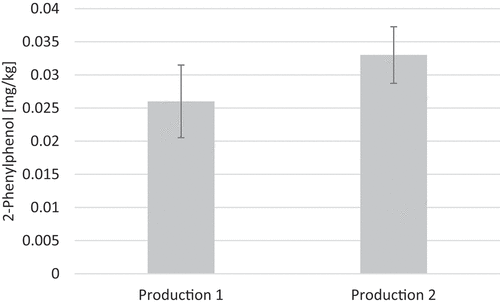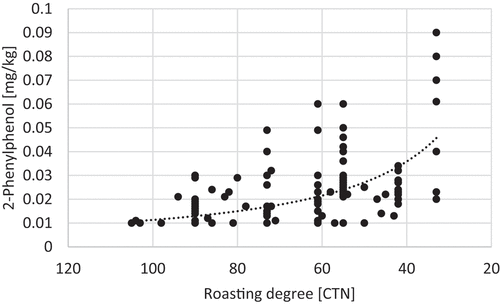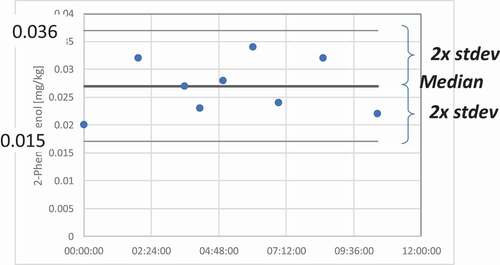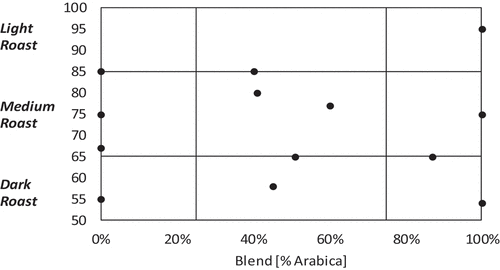 ?Mathematical formulae have been encoded as MathML and are displayed in this HTML version using MathJax in order to improve their display. Uncheck the box to turn MathJax off. This feature requires Javascript. Click on a formula to zoom.
?Mathematical formulae have been encoded as MathML and are displayed in this HTML version using MathJax in order to improve their display. Uncheck the box to turn MathJax off. This feature requires Javascript. Click on a formula to zoom.ABSTRACT
Traces of the phytosanitary agent 2-phenylphenol in roasted coffee are not necessarily related to residues of agrochemicals. This study shows that roasting of coffee generates 2-phenylphenol at low level. Green coffee samples (approx. 1500) were found negative for 2-phenylphenol and the levels of 2-phenylphenol increased as a function of roasting degree. Packaging materials as a source of contamination can be excluded. The exposure to 2-phenylphenol by coffee consumption is negligible and contributes to less than 0.004% of the ADI. The presence of 2-phenylphenol residues in roasted coffee above the regulatory limits for green coffee must not necessarily lead to the conclusion that the green coffee, either conventional or organic, was non-compliant.
Introduction
Coffee is a highly appreciated beverage in many countries and consumed on a regular basis on many different occasions. Per capita consumption can be as high as 12 kg/year, e.g. in Finland (CBI Ministry of Foreign Affairs. Citation2019). Across different countries and regions, the coffee culture can vary significantly. While, for example, Finish and Greek consumers typically choose light roasted coffee, Italian and Spanish consumers prefer typically dark roasted coffee. Numerous preparation modes, such as Turkish coffee, filter coffee, and espresso, exist and influence the beverage in its appearance and sensory profile.
There are over 60 different geographical locations producing coffee, located in the Coffee Belt between the tropic of Cancer and Capricorn. Mature coffee cherries are reaped, commonly sun and air dried to a moisture level of <13% and then further processed in dedicated coffee mills to remove husks and foreign material.
To make green coffee beans palatable for consumption, a dry heat treatment process is applied by which the green coffee beans are roasted (e.g. 200–230°C) for a specific time, usually between 6–20 min, thus developing their typical brownish colour and complex mixture of compounds that create the desired sensory profile. The applied roasting conditions depend on the targeted sensory profile. Roasting, at lower temperature and/or shorter time, results in a “lighter” roasted product, while at higher temperatures and/or longer time a “darker” roasted product is obtained.
In the past years, phytosanitary substances like mepiquat, furfural, phthalimide and 2-phenylphenol have occasionally been reported to be found in roasted or soluble coffee, either conventional or organic (Bessaire et al. Citation2016; Schenk and Süsse-Herrmann Citation2021). Reported levels in the finished product under suspicion could lead to the assumption that the green coffee did not comply with the corresponding regulatory limits (EC Citation2005). Investigations by manufacturers did not support this, as these pesticides were neither found in the green coffee monitoring program nor in the specific green coffee batches.
2-phenylphenol is a commonly-used fungicide. In food, it is mainly used for the preservation of citrus fruits (Eckert et al. Citation1969). Coffee does not require preservation as both green and roasted coffee are shelf-stable at a moisture of 13% (Swiss Food Regulation Citation2005; Spain Real Decreto Citation2012) and 5% (Swiss Food Regulation Citation2005), respectively.
To gain a deeper understanding on reported 2-phenylphenol residues in roasted coffee, the following aspects were investigated: contamination of green coffee, generation of 2-phenylphenol as a function of roasting parameters and transfer to the cup.
Green coffee samples of different origins were analysed to evidence that 2-phenylphenol is not used on green coffee, but residues in the roasted coffee are related to the roasting process. Additionally, it was of interest to describe the variability within the same production batch as well as between two production batches. To estimate consumer exposure, the transfer rate into the brew using two different preparation modes was assessed. Roasting trials with a roaster having a much smaller dimension and powered by electricity were performed to exclude 2-phenylphenol generation through other sources. Commercial packaging materials were analysed to exclude 2-phenyphenol residue origin from the packaging material.
Materials and methods
Roasting experiments were carried out in a drum Roaster (Neptune 150), on a 320 kg batch.
The roasting degree was measured using an in-house method, i.e. Colour Test II Neuhaus (CTN). In brief, the surface of the roasted and ground coffee sample is irradiated by a monochromatic infrared light and the reflected light intensity is measured by the instrument. The roast colour is expressed in CTN. The darker the roast coffee, the lower the CTN.
Analysis of 2-phenylphenol was carried out for green coffee samples by the Nestlé Quality Assurance Center of Cergy (France) and for roasted coffee samples by Neotron SpA (Modena, Italy) (Relena Citation2016).
For green coffee samples, analysis was performed following the European Norm EN 15662:2018 (QuEChERS-based procedure) with minor modifications. The green coffee sample (2 g) was weighted into a 50 ml plastic tube and 10 ml of water was added. The extraction was performed by a solid-liquid partitioning using acetonitrile (10 ml) and extraction salts (MgSO4 + NaCl + Na3Citrate + Na2HCitrate) followed by a clean-up of the supernatant using dispersive solid phase extraction (d-SPE) with PSA (Primary Secondary Amine) and MgSO4.
The extraction of roasted coffee was performed according to a modified QuEChERS method for acidic pesticides (Relana, Position paper 16–05 Version 2016/08/08). Each sample was weighted (2 g) into a 50 ml plastic tube; 10 ml of water and 1 ml of NaOH 10N were added. The sample was placed in a water bath at 60°C for 1 hour. Then, 1 ml of HCl 12N solution was added and the sample was extracted twice with 8 ml of dichloromethane. Both types of extract were analysed by gas chromatography with tandem mass spectrometric detection (GC-MS/MS). Analyses were performed on an Agilent 7890B gas chromatograph and a HP-5MS (30 m, 0.250 mm, 0.25 mm) (green coffee) or a DB5-MS-UI (30 m, 0.250 mm, 0.25 mm) GC column (roasted coffee). Acquisition was performed on an Agilent 7010B GC Triple Quad instrument using tandem MS in selected reaction monitoring mode (MRM) by monitoring at least two transition reactions: 169 → 115 (quantifier green coffee), 169 → 108 (quantifier roasted coffee), 170 → 141 (qualifier green and roasted coffee) and 170 → 115 (qualifier roasted coffee).
Results and discussion
Green coffee beans
Between 2015 and 2020, approximately 1,500 green coffee bean lots were tested in the frame of a monitoring plan for contaminants for the presence of 2-phenylphenol by two globally leading coffee companies. 2-phenylphenol was detected in none of the green coffee bean samples (LoQ < 0.01 mg/kg).
Roasted coffee beans
Between 2020 and 2021, 162 commercial roasted coffee products were tested for the presence on 2-phenylphenol. In 82% of these samples, 2-phenylphenol was found above the LoQ (>0.01 mg/kg). To investigate 2-phenylphenol generation during roasting, 37 commercial batches of green coffee beans were analysed for 2-phenylphenol, then roasted on the same industrial roaster to commercial coffee products and analysed on 2-phenylphenol. 2-phenylphenol was not detectable in any of the selected 37 green coffee batches. These green coffee batches were then either blended or individually used for manufacturing in nine different types of finished product, having different roasting levels. The nine finished products were analysed for 2-phenylphenol, and the results are summarised in . The measured values ranged between 0.01 mg/kg and 0.046 mg/kg. The darker the roasting level, the more 2-phenylphenol was found.
Table 1. 2-Phenylphenol levels of green coffee beans and corresponding roasted coffee
The fact that green coffee samples, negative for 2-phenylphenol, show clear measurable levels of 2-phenylphenol after roasting demonstrates its generation during that process.
To better understand the relation between the roasting degree and the generation of 2-phenylphenol, the roasting degree of commercial coffee products was correlated with measured 2-phenylphenol levels (). The darkest roasted coffee product showed the highest 2-phenylphenol levels. Measured data ranged between <0.010 and 0.067 mg/kg. Some very dark (CTN < 40) roasted coffee products may even exceed the MRL for green coffee of 0.05 mg/kg defined in the European Union (EC. Citation2005). Apart from some very light roasted (CTN > 90) coffee products, 2-phenyphenol was present at quantifiable levels (LoQ 0.01 mg/kg) in all analysed samples.
To understand the generation behaviour of 2-phenylphenol during the roasting process, two green coffee samples, an Arabica and a Robusta, were roasted for 13 min. Every minute over the roasting process, samples were taken and analysed for 2-phenylphenol (), showing a measurable 2-phenylphenol formation after 9 min.
Intra- and inter- batch method variability
Intra- and inter- batch variability was analysed to understand better the generation of 2-phenylphenol in roasted coffee, as detailed in . For intra-batch testing, 10 samples were evenly taken over a 10-hour filling process. Measured results ranged between 0.020 and 0.034 mg/kg, having a median of 0.026 mg/kg and a standard deviation of 0.005 mg/kg. The measurement uncertainty of the analytical method amounts to 30%. This leads to the conclusion that intra-batch variability can be neglected.
Figure 4. Inter batch variability results evidence that production batch 2 is statistically significantly higher (18%) than production batch 1. The error bars represent the standard deviation within one production

The inter-batch variability was assessed by comparing 2-phenylphenol results of two batches of the same recipe. One production batch was analysed taking 10 samples (intra-batch variability) and the other batch was analysed taking seven samples. 2-phenylphenol results for the batch with 10 samples ranged between 0.020–0.034 mg/kg with a median of 0.026 mg/kg, while the 2-phenylphenol contents of the second batch ranged between 0.024 and 0.036 mg/kg with a median of 0.033 mg/kg. The 2-phenylphenol levels in both productions were significantly different (p = .026), with the second batch being 18% higher (). These findings indicate that the 2-phenylphenol level in roasted coffee depends not only on the roasting parameters but also on other parameters, e.g. composition of green coffee beans.
Coffee packaging
As 2-phenylphenol has a wide range of applications (Votavová et al. Citation2014), it could theoretically be used for protecting or sanitising packaging materials (laminates). To exclude a potential migration from the laminate into the roasted coffee, five different laminate samples of commercial packaging materials were analysed. All laminate samples were found to contain no 2-phenylphenol (). The analysed laminates were used in two different factories and analysed by the same laboratory. It is important to note that packaging materials, before approval for use, are subjected to a very detailed assessment on its composition and application to comply with migration limits into food as per regulatory requirements.
Table 2. 2-phenylphenol results analysed in five different packaging laminates
Soluble coffee
A total of 14 different soluble coffee products, commercialised in Europe, was analysed for 2-phenylphenol. The sample, originating from four different manufacturing sites, was selected based on three parameters: blend (Arabica vs. Robusta), roasting degree (CTN 55–95) (see ) and extraction technology. No 2-phenylphenol was detected in any of the 14 soluble coffee samples, the limit of quantification being 0.01 mg/kg. Assuming a similar level of 2-phenylphenol in the survey performed on roasted coffee before extraction, these results indicate only a limited transfer of 2-phenylphenol into the brew.
Transfer into cup
To estimate consumer exposure to 2-phenylphenol, the transfer from roasted coffee into the brewed coffee was assessed. Two different preparation modes were investigated, drip filter and espresso machine. Details of the preparation are summarised in . After the total solids were determined, extracts were freeze-dried prior to 2-phenylphenol analysis. The 2-phenylphenol transfer rate was calculated using Equation (1).
Table 3. Coffee preparation mode and analytical results
The transfer rates for drip filter and espresso machine were determined as 15.7% and 16.2%, respectively. These findings lead to the conclusion that the transfer rate into the brew is low and the preparation mode can be neglected. Additionally, it is well aligned with the results found in soluble coffee, where no sample of coffee brew contained <0.010 mg/kg of 2-phenylphenol.
where
Roasted coffee weight [g]: Weight of the roasted coffee used for the cup preparation
Extract weight [g]: Weight of the consolidated beverages
Total Solids [%]: Total solids of the coffee extract
2-phenylphenolroasted coffee [mg/kg]: 2-phenylphenol analysed in the roasted coffee
2-phenylphenolfreeze dried coffee extract [mg/kg]: 2-phenylphenol analysed on the freeze-dried extract
Assessment of potential 2-phenylphenol exposure through coffee
For the health assessment of 2-phenylphenol exposure through coffee, the concept of the acceptable daily intake (ADI) was applied. The ADI is considered as safe intake level for a healthy adult of normal weight who consumes an average daily amount of the substance in question.
In 2000, the World Health Organization (WHO) evaluated the ADI for 2-phenylphenol at 0.4 mg/kg body weight (WHO Citation2000). Based on the ADI, an adult person with a body weight of 60 kg, could safely be exposed daily to 24 mg 2-phenylphenol.
Estimating the daily exposure to 2-phenylphenol by considering the highest measured level of 2-phenylphenol in roasted coffee (0.12 mg/kg), the transfer rate of 16% into the brew and a daily coffee consumption of 5 cups prepared with 8 g of coffee per cup result in less than 0.0008 mg 2-phenylphenol, representing less than 0.004% of the ADI.
Conclusions
This study shows that coffee roasting generates 2-phenylphenol at low levels, which increase as a function of the roasting degree of the bean. Measured residues in roasted coffee are not related to the application of phytosanitary substances on green coffee. It must not be concluded that green coffee, either conventional or organic, did not comply with the MRL defined by the EU. This study indicates that Arabica beans tend to generate slightly higher amounts of 2-phenylphenol during roasting than Robusta beans. Packaging material as a source of contamination can be excluded. Estimated exposure of coffee drinkers to 2-phenylphenol can be considered as negligible. Based on the currently available information, similar observations can potentially be made in other food manufacturing processes, where the Maillard reaction plays a key role for colour and taste generation, e.g. baking of cereal-based foods and cocoa roasting. A more systematic approach is currently under development to investigate the potential generation of further phytosanitary substances during coffee roasting. Based on these findings, more detailed studies might be needed to describe the generation chemical pathways.
Acknowledgments
The authors thank Neotron SpA (Modena, Italy) for the 2-phenylphenol analyses.
Disclosure statement
No potential conflict of interest was reported by the author(s).
Additional information
Funding
References
- Bessaire T, Tarres A, Stadler RH, Wermann S, Hofmann J, Theurillat V, Combremont R, Delatour T. 2016. Mepiquat: a process-induced by-product in roasted cereal-based foodstuff. J Agric Food Chem. 64(5):1185–1119. doi:https://doi.org/10.1021/acs.jafc.5b05418.
- CBI Ministry of Foreign Affairs. 2019. Exporting coffee to Finland, Last update 2019. [accessed 2021 Jun 15]. https://www.cbi.eu/market-information/coffee/Finland#:~:text=Finland%20has%20the%20highest%20per%20capita%20consumption%20of%20coffee%20in,and%20Norway%20(8.7%20kg).
- EC. 2005. Regulation (EC) No 396/2005 of the European Parliament and of the Council of 23 February 2005 on maximum residue levels of pesticides in or on food and feed of plant and animal origin. Off J L. 70.
- Eckert JW, Kolbezen MJ, Kramer BA. 1969. Accumulation of o-phenylphenol by citrus fruit and pathogenic fungi in relation to decay control and residues. Proc 1st Int Citrus Symp. 2:1097–1103.
- Relena. 2016. Position paper 16-05 “Analysis of Acidic Herbicides with respect to the related residue definitions.” Version 2016/08/08
- Schenk G, Süsse-Herrmann O. 2021. Traces of phytosanitary substances in roasted coffee are not necessarily related to agrochemical residues in green coffee beans: Deutsche Lebensmittel-Rundschau. 117 Jahrgang:207–214.
- Spain Food regulation. 2012. Real Decreto 1676/2012, de 14 de diciembre, por el que se aprueba la norma de calidad para el café.
- Swiss Food Regulation 817.02. 2005. Moisture limits for green and roasted coffee, chapter 30, article 310 & 311.
- Votavová L, Hanušová K, Vápenka L, Dodiáš J, Kvasnička F. 2014. Occurrence of 2-phenylphenol in food paper packages. Cent Eur J Chem. 12(11):1162–1168.
- World Health Organization. 2000. Evaluations of the Joint FAO/WHO Expert Committee on Food Additives (JECFA): 2-phenylphenol report TRS 901-JECFA 55/44.




